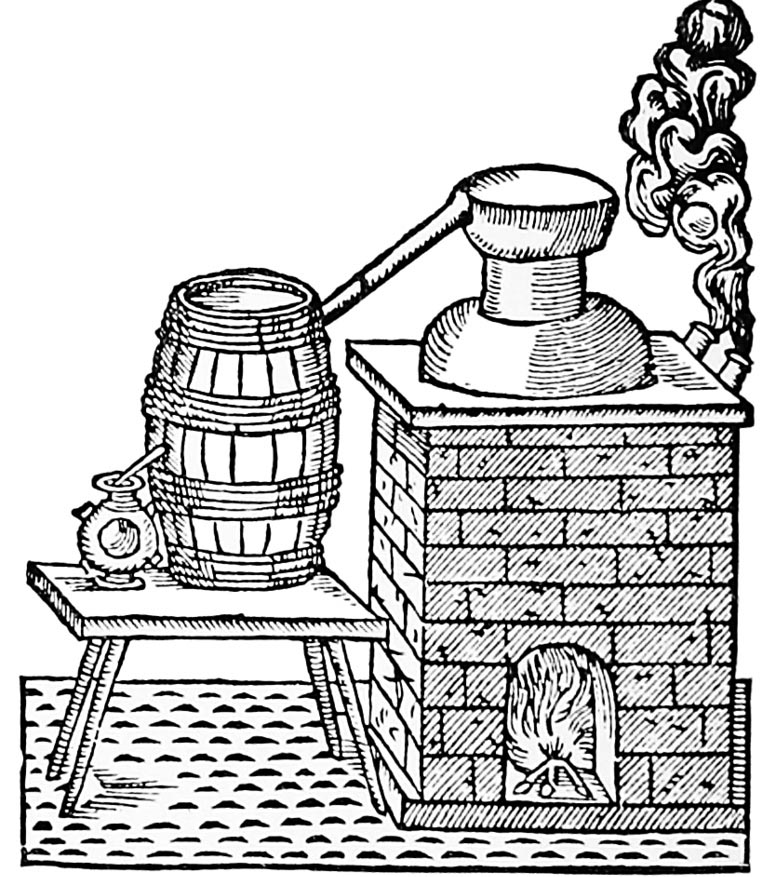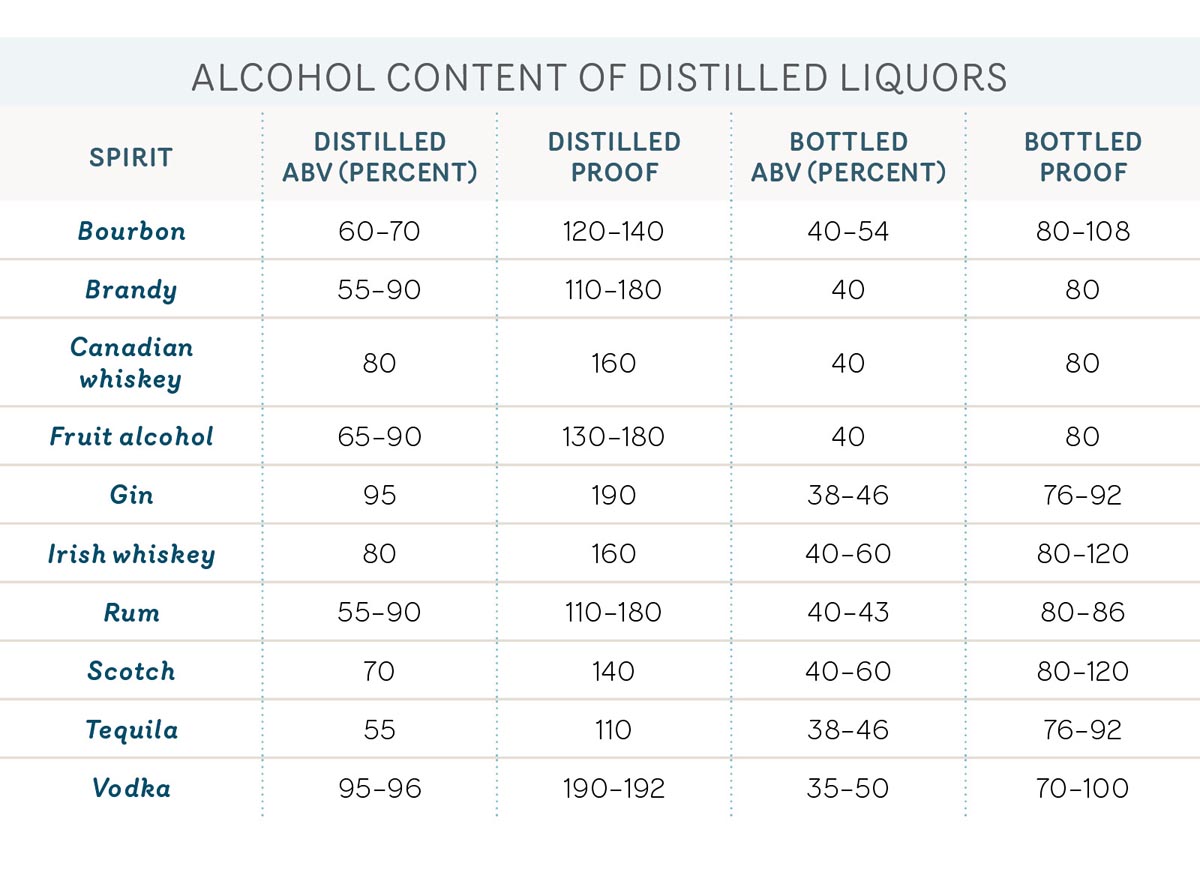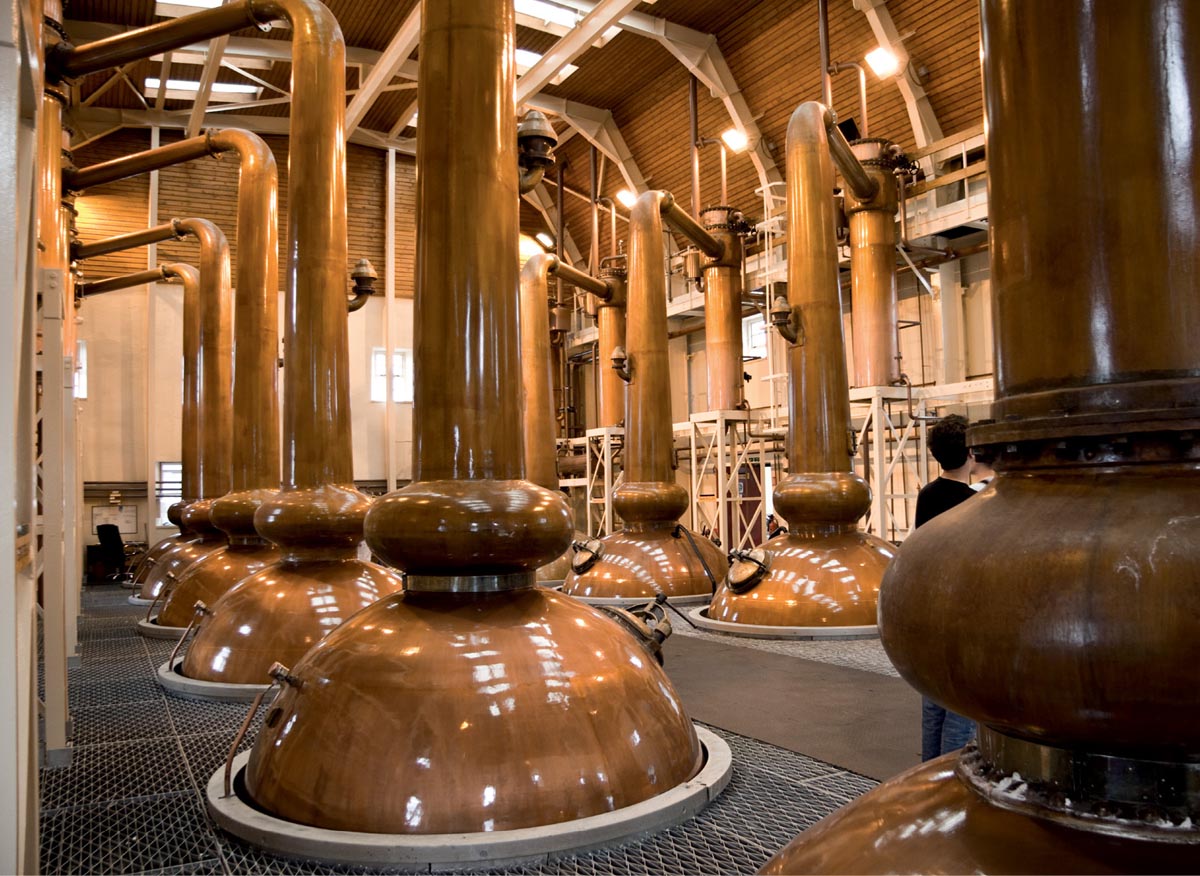
A medieval still for making aqua vitae
All liqueurs are composed of just three components: liquor (distilled spirits), flavoring, and sugar. Liquor is distilled from fermented fluids, either wine (fermented sugary liquids such as fruit juice, sugarcane juice, or elderflower juice) or beer (starchy mashes such as barley mash, rice mash, or mashed potatoes). Since alcohol boils at a lower temperature than water — 173°F (78°C) compared to 212°F (100°C) — when wine or beer are heated, more alcohol than water turns into vapor.
Liquor is made by capturing that vapor and cooling it until it returns to a liquid state. The resulting spirit has a higher alcohol content than the original beer or wine, and because aromatic chemicals are also highly volatile, it has a more concentrated flavor as well.
The art of distillation is ancient. Mesopotamians were capturing the scents of aromatic plants through distillation more than 5,000 years ago. Written documents suggest that the earliest distilled alcoholic beverages were made by the Chinese, who concentrated alcohol from fermented grain about 2,000 years ago. By the tenth century, privileged Chinese were drinking distilled alcohols, and by the thirteenth century, spirits were being sold commercially.
By 1100 alcohol distilled from wine had a reputation as a valuable medicine in Italy, and throughout Europe alchemists viewed distilled alcohol as a powerful quintessence or vaporous “fifth element” that in addition to the four basic elements (earth, water, air, and fire) made up the world.

A medieval still for making aqua vitae
In the early fourteenth century, the Valencian alchemist and physician Arnaldus de Villanova, in his medical book on wine, Liber de Vinis (the first mass-printed wine book), dubbed the essence of wine aqua vitae, or “water of life.” The term has given name to most distilled spirits, including Scandinavian aquavit and French eau-de-vie. In English, “whiskey” is the anglicized version of the Gaelic beatha, “water of life.” Even the term “spirit” identifies alcohol as the soul of fermentation.
Spirits distilled from wine have different characteristics from those distilled from beer. Fruit-based spirits are divided between brandy (made from grapes) and fruit alcohol (made from other fruits). Grain-based spirits are divided among single-malt whiskey (made from malted barley), whiskey and gin (made from grain and malted barley), bourbon (made from corn and malted barley plus a regulated amount of other grain), and vodka (usually made from grain, but also from potato or other starches). Rum is distilled from fermented molasses or sugarcane, and tequila and mescal are distilled from fermented agave.

The following are the liquors most commonly used as bases for concocting liqueurs.
Brandies are distilled from grape wine. The two most prestigious are Cognac and Armagnac, the first named for a town north of Bordeaux in southwest France and the second for a region south of Bordeaux. Both are made from Trebbiano grapes, which are used to make more wine than any other grape in the world. Trebbiano grapes produce fresh, fruity, undistinguished wines that do not age well, but because of their fruitiness and high acidity, retain full flavor throughout distillation.
Cognac is double distilled with the lees still in the juice. Lees are the sediment of dead yeast that falls to the bottom of the tank after fermentation. They are quite pungent and give Cognac a savory, yeasty quality that balances the sweetness of the grape. Cognac is usually distilled to an alcohol content of 70 percent.
Armagnac is single distilled without lees to about 55 percent alcohol. The shorter fermentation time preserves more of the fruit’s volatile acids, which makes Armagnac rougher and more assertive than Cognac.
By law, both Armagnac and Cognac are aged in new French oak barrels for flavor; the oak flavors dissipate as a barrel is used for a minimum of six months, but most brandies are aged for at least two years. The best Armagnac is aged for 20 years or more; Cognac can be aged for over 60 years before being bottled. Both are diluted to about 40 percent alcohol, and their flavor and color may be corrected with sugar, oak extract, and caramel before bottling.
Marc and grappa are the French and Italian names for single-distilled brandy made from pomace, the fermented skins, seeds, stems, and pulp left over from pressing grapes for wine. This solid debris still has some juice and a lot of sugar and tannins remaining in it, which, with the addition of water and a second period of fermentation, yield a pungent wine. Distillation concentrates the flavor, producing a brandy that is known for its strength and sharpness.
Traditionally, marc and grappa were bottled as is, without filtering out the sharper alcohols created in the distillation process, but today more refined aged products are being produced. With age, marc and grappa can develop the same flavor chemicals as those in blue cheese, a quality that is highly prized by aficionados.
Distilled beer (minus the hops) is aged in wood to develop color and flavor, eventually producing whiskey. Like beer, much of its primary character depends on the mix of grains used in its preparation. Whiskeys made with all malted barley are called “single-malt.” Those made with a combination of malted barley and grains are called “grain whiskey.” These can be named for the type of grain used, such as rye, or they can be named for their place of origin, such as Scotch, Irish, or Canadian.
Scotches, especially single-malt types, are some of the most flavorful and nuanced (and most expensive) whiskeys in the world. One of the characteristic qualities of Scotch is a smoky aroma that comes from drying the malt over a live fire. In the western and northern areas of Scotland, called the Islands and Highland region, respectively, the fuel usually includes peat, a form of dried compost that gives peat-smoked Scotch a particularly earthy character. There are two types of Scotch that are commonly available:

A modern whiskey distillery in Scotland
Single-malt Scotch is made from 100 percent malted barley, and each brand is made at a single distillery, usually in the Highland region of Speyside or on one of the western islands of Arran, Jura, Mull, Orkney, or Skye. The Isle of Islay to the south is considered its own single-malt region. Highland single malts include Balvenie, Cragganmore, Dalmore, Glenfiddich, McClelland’s, and The Glenlivet. Island single-malt distilleries include Arran, Bruichladdich, Jura, and Talisker. Laphroaig is the most popular Islay Scotch.
Blended Scotch is a blend of different single-malt and grain whiskeys that usually come from more than one distillery. This category accounts for 90 percent of the whiskey produced in Scotland. They are usually less than half single malt, and each brand has its own style. Popular blended Scotches include Dewar’s, Johnnie Walker, Cutty Sark, and J&B.
Regardless of its type, by law all Scotch must be distilled in a Scottish distillery. It cannot be distilled to alcohol strength of more than 94.7 percent so that it retains the flavor of its raw materials. It must be aged in Scotland in oak barrels for at least three years. And it cannot be bottled at less than 40 percent alcohol by volume.
Scotch is typically aged in barrels that were previously used for aging wine or other liquors, to ensure that the most volatile elements in the wood have dissipated. The most common casks are sherry or bourbon casks, most typically bourbon, since there is a nearly endless supply because of U.S. regulations that bourbon must always be aged in new barrels.
Sometimes a Scotch label will specify the type of cask used. It will also tell you if the Scotch is bottled undiluted, specified as “cask strength,” which is typically between 50 and 60 percent ABV. If the Scotch is single malt, the name of the distillery will be specified as well as the fact that it is single malt. If it has been cask aged for any amount of time past the minimum requirement, the number of years will be listed. The age on the label is the amount of time the Scotch spent in a barrel before bottling. If there is a date on the bottle, it is the date of the bottling.
Irish whiskey. Like Scotch, Irish whiskey can be single malt, single grain, or blended. Irish whiskey has a unique classification, “pure pot still whiskey,” referring to a pot or batch method of distilling rather than the column, or continuous, method. Many whiskeys are batch distilled, but the “pure pot” designation for Irish whiskey means that the liquor is made with 100 percent barley, about half of which is malted. This is different from single malt, which is also 100 percent barley, but all of that is malted.
Irish whiskeys are typically triple distilled, which makes them lighter in color and less flavorful than Scotch, and they are never cooked over peat, so they do not have a smoky character.
There are far fewer distilleries in Ireland than in Scotland. Bushmills makes both blended and single-malt whiskeys. Jameson is the primary distiller of pure pot still Irish whiskey; they also make a blended whiskey.
Canadian whiskey. Made mostly from a blend of grains, Canadian whiskey is known for its mild flavor and delicate aromas. Canadian whiskey often includes rye in its grain blend, and a few Canadian whiskeys are 100 percent rye. By law they are aged for at least three years in oak casks. The most popular brands are Canadian Club and Crown Royal. Glen Breton Rare, from Nova Scotia, is a boutique single-malt Canadian whiskey. Canadian whiskey can include small additions of other whiskeys, brandies, wine, and/or rum, up to 9 percent of the blend.
Bourbon whiskey. Named for the county in Kentucky that was its birthplace, bourbon is made from corn. By law bourbon must be at least 51 percent corn, but in practice the percentage is closer to 70 percent, with the remainder a mixture of malted barley, wheat, and/or rye. Most bourbon is double distilled to an ABV of 60 to 80 percent and then aged for a minimum of two years in new charred American oak casks, which give bourbon a deep amber color and a pronounced vanilla flavor note.
Unlike French brandies and Canadian whiskeys, caramel color, sugar, and other flavorings are not permitted in bourbon production. Nothing other than grain, yeast, and water goes into a bottle of bourbon.
Although Kentucky continues to be the largest bourbon-producing state, Tennessee whiskey is similar, except that it is maple-charcoal filtered before aging, a step that gives it a distinctive flavor. The largest producer of Tennessee whiskey is Jack Daniel’s. Popular Kentucky bourbons include Jim Beam, Knob Creek, Maker’s Mark, Wild Turkey, and Woodford Reserve.
Rye whiskey. In the United States, where most rye whiskey is distilled, the formula must contain at least 51 percent rye grain. Canadian whiskey, which usually contains some rye, is sometimes referred to as rye whiskey, although Canada does not stipulate the amount of rye in whiskeys.
Rye is harsher, less sweet, and not as syrupy as bourbon, giving it a complex, and some might say coarse, flavor profile. The major producers are Jim Beam, Heaven Hill, Buffalo Trace, and Old Overholt.
Vodka can be distilled from a fermentation of any substance high enough in carbohydrates to produce alcohol. In Russia, where it originated, vodka (which means “little water” in Russian) was made from the cheapest source available — commonly grain (sorghum, corn, rye, or wheat), potatoes, or sugar beets.
The specific base ingredient is unimportant because vodka is distilled to rid it of all aromatics and then filtered through charcoal to produce a smooth, neutral, pure spirit. Typically, vodka is continuously distilled to 95 percent ABV and bottled without further aging at around 40 percent ABV.
Because the goal of vodka is purity, filtered vodkas are the norm, although small distilleries are increasingly producing unfiltered vodkas, which have more flavor and character. Smirnoff and Stolichnaya are the most well-known Russian vodkas. Absolut and Finlandia are popular Scandinavian vodkas. Grey Goose is from France.
Gin, a neutral spirit flavored with juniper berries, comes in two styles. The most common, English-style or London dry gin, is made by diluting a double-distilled 95 percent grain spirit with water, adding juniper berries and other flavorings — most often coriander but occasionally other spices — and distilling it a third time to flavor it and return the distillation to 95 percent ABV. The distillate is diluted before bottling to between 37 and 47 percent ABV. Brands of English-style gin include Beefeater, Bombay, Boodles, Gordon’s, and Tanqueray.
The Dutch method of distilling gin is made by double- or triple-distilling a fermentation of malt, corn, and rye to a fairly low alcohol level, around 30 percent. At that ABV, many flavors from fermentation are still present in the spirit. Juniper and other spices are added, and the spirit is distilled one more time to an ABV of around 40 percent. It is then bottled without further dilution. Dutch-style gins include Bols and Hendrick’s. Plymouth is a Dutch style of gin that can only be made in Plymouth, England, and genever (called “Holland gin” in England) is the original Dutch gin, flavored assertively with juniper (genièvre is French for “juniper”).
The aromatics in gin, which come from terpenes in the spices, are typically piney, citrusy, or floral. They can be subtle or pronounced, with the Dutch method producing the most flavorful gins. Some distilleries flavor their gins with scores of ingredients. Hendrick’s gin, made in Scotland, is distilled with cucumber and roses; Beefeater gin contains nine herbs and spices, including juniper, angelica, and coriander, as well as licorice, almonds, and Seville oranges.
Rum contains neither fruit nor grain. It is distilled from fermented sugarcane juice or molasses, resulting in a rough alcohol that can be light or dark. Traditional dark or black rums, which come mostly from Jamaica and the French-speaking Caribbean islands, are fermented with a special yeast (Schizosaccharomyces) that produces a large amount of fruity-tasting esters. The fermentation is distilled in pot stills in small batches to a low alcohol concentration in order to preserve as much of the aromatic components as possible. The spirit is aged in charred American oak barrels, usually old bourbon casks, from which it gets most of its color.
Light rum is fermented with conventional yeasts and distilled industrially to about 90 percent ABV. The rum is matured to mollify its rough edges and usually filtered to remove residual color from the molasses. It is diluted to between 40 and 43 percent ABV before bottling. Golden rums are aged in oak barrels to mellow them further and to develop a light honey color. Overproof rums are diluted less before bottling and can be as high as 75 percent ABV. Premium rums that are aged for years in oak resemble brandies in appearance and flavor. Cachaça is Brazilian rum made exclusively from sugarcane juice. Charanda is sweet vanilla-tasting Mexican rum.
The agave, a succulent plant similar to cactus that grows at high altitudes mostly in the Jalisco state of Mexico, is the base for the indigenous liquors tequila and mescal. Both are made mostly from the hearts (piñas) of blue agave (Agave tequilana), which are rich in fructose and inulin (a form of indigestible long-chain sugar). Agave for tequila is steamed to break down the sugars before fermentation. Agave for mescal is roasted over charcoal, infusing the piñas with smoke that carries into the aroma of the finished spirit. The cooked piñas are mashed with water and fermented with yeast. The resulting liquid is distilled. Tequila is distilled industrially. Mescal is double distilled in small batches in pot stills made out of clay or metal.
Tequila that is bottled without any aging is called blanco (white) or plata (silver). Oro (gold) tequila is blanco tequila with added caramel coloring and flavoring to make it resemble aged tequila. Reposado (rested) tequila is aged for between two months and one year in oak barrels. Añejo (aged) tequila is aged in oak for between one and three years, and maduro (extra-aged) is held for more than three years.
All mescal is aged. Blanco or joven (young) mescal is aged for less than two months and is colorless. Reposado and añejo mescals are aged similarly to tequilas but in smaller barrels.